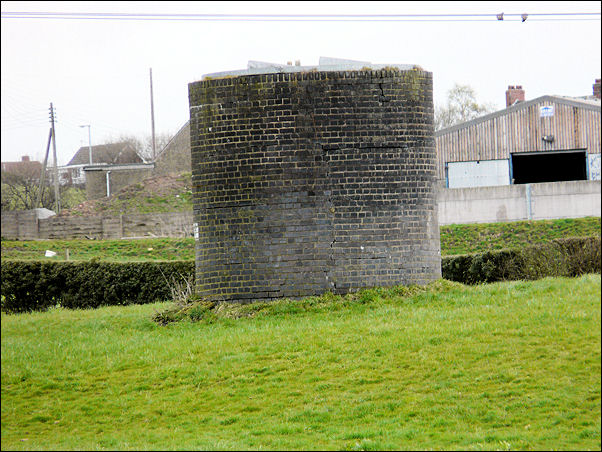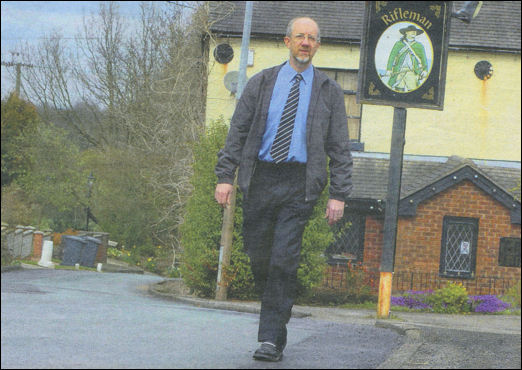|
the historic boatman's walk to
Kidsgrove
  
click the
"contents" button to get back to the main index & map
next: Kidsgrove - an historic town
previous:
James Brindley - canal
engineer
|
Historian Fred Hughes
writes....
Musician Nigel Shaw’s family has come to Stoke on Trent to navigate
the Harecastle Tunnel.
“It’s something we’ve wanted to do for a while,” says Nigel. “We holidayed
on the Trent and Mersey Canal a couple of years ago and were fascinated by
the district’s industrial heritage but didn’t manage to go through the
tunnel. So we’ve come back for another go.”
Nigel and his wife Janine teach music. Sons William age 16 and David age
11 are pupils at Chetham Music School in Manchester.
"Canal boating is addictive,” continues Nigel. “We plan to go along the
Shropshire Union later but this time we’ve come just to experience the
tunnel.”
William and Janine help Nigel out as deckhands giving David time to tell
me about the Kidsgrove boggart.
“I’ve discovered there is a ghost of a woman who was murdered around
here,” he enthuses. “People say it can be seen in the tunnel. I just
want to find out if it’s true.”
The story of the boggart is an enduring one with many variations about a
woman who hitched a lift on a boat and was done to death during the
journey. Awkwardly not much information is available to substantiate a
murder at this point or even in which of the two tunnels the despicable
deed was done. But who am I to stand in the way of a good haunting.
“Perhaps if we see the apparition we’ll tell you about it on the other
side,” laughs Janine.
|
These days the journey through Harecastle Tunnel takes about 45
minutes. So, having waved the Shaw’s off my companion, historian Steve
Birks and I locate Boathorse Lane and head-off for Kidsgrove.
“The old legging tunnel was a three hours journey giving the boatmen
plenty of time to meet their boat while they walked their horses over the
top,” explains Steve, “But we’ll have to make haste to be on time for the
Shaw’s. I’m fairly certain the lane we’re following is the original one
used by the boatmen. In fact a map of 1775 shows it with a reference near
to the tunnel entrance saying ‘cut under ground’. I reckon that the
mapmaker Yates was aware of the tunnel even though it didn’t open until
two years after his map was published. Brindley quite possibly used the
road while plotting his land measurements. Perhaps he named it knowing it
was going to be the route of the boatmen. But at the time Yates draws it
without a name.”
Boathorse Lane leads us through the local authority’s traveller’s park
which stands on the site of an old mining village, demolished in the
1960’s, called Linehouses.
“You’ll note the valley rising sharply at this point,” Steve points out.
“But as it climbs from the foot of Yeld Hill it gets to be a bit of a
haul. Looking from the top you’ll have to guess the line of the tunnel but
you might notice an airshaft along the way that stands some distance from
the lane giving an indication of the tunnel’s location.”
It’s easy to imagine the immense traffic flow as the drovers weaved
in and out of the early coalmines that peppered the area. Some interesting
shallow declivities in surrounding fields mark out early bell pit
activity. These days the land near the top of the hill is owned by
Ravenscliffe House Farm and Green’s abattoir.

airshaft to Brindley's canal tunnel near Woodstock Road
“For some reason the lane was changed to Acres Wood Road at this point
as it winds through the land contours descending into Kidsgrove,” says
Steve. “As you pass Woodstock Road you will see an airshaft on the right
about 150 metres into a field. That’s the true tunnel line.”
|
Turning the bend we come across an isolated wayside inn called the
Rifleman. Was this a stopping point for the boatmen.
“I rather think not,” advises Kidsgrove historian Philip Leese.
“For one the boatmen wouldn’t have had the time to pause for a pint. And
for two the first mention of this pub wasn’t until 1854 when it was
reported that landowner Ralph Sneyd sold the house to a villager John
Cumberland. Cumberland seemed to have been a common illiterate local who
signed his deeds with a cross. But by 1873 he was known as a beer
seller. Soon after this he was calling himself a gentleman and a yeoman
writing now with a proper signature. As he advanced successfully he sold
the pub to James Beech.
Kidsgrove Rifle Volunteers had been formed in 1860 and were shooting in
nearby Target Wood. The connection comes in 1876 when the pub was being
called the Rifle Volunteers with stables and a license to sell wine as
well. The number of coalmines nearby no doubt did much for his trade.”
|

Steve Birks walks
along Boathorse Road past the Rifleman pub
The journey from the Rifleman is all downhill, past the entrance to
Bathpool where the name Acres Wood curiously changes back to Boathorse
Lane. Beneath the modern streets the ancient paths can be imagined peeking
from a bygone age in a town where beauty once collided with industry.
Bay-willow and aspen challenge oak and silver-birch for territorial
advantage as the lane forfeits ground to Kidsgrove’s high streets. Here
our road turns towards the railway station where the canal emerges from
its one-and-half-mile subterranean journey. And we’re just in time to meet
the Shaw family. Even though it’s a warm spring day I notice the quartet’s
pale-faced shivering looks. So, did they see the boggart?
“No, it was just that blooming cold!” exclaims Nigel. Janine looks
perished as well, wrapped tightly in her weatherproof anorak. “It was
cold and damp and to some extent a bit boring,” she complains, “But it
was an interesting experience.”
|
While William and his dad moor the boat I ask young David if he’d seen the
boggart.
“No; it was a bit spooky nevertheless,” he grins. “But you never know – on
the way back perhaps.”
next week: Kidsgrove - an historic town
  
click the
"contents" button to get back to the main index & map
next: Kidsgrove - an historic town
previous:
James Brindley - canal
engineer
|